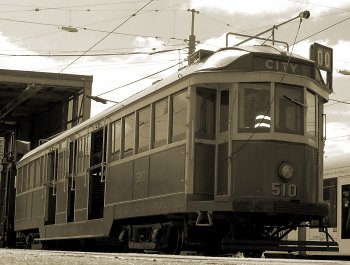Melbourne Tram Museum
- Follow Melbourne Tram Museum on Twitter
- Follow Melbourne Tram Museum on Facebook
- Follow Melbourne Tram Museum on Instagram
- Follow Melbourne Tram Museum on Pinterest
- Follow Melbourne Tram Museum on Tumblr
- Subscribe to Melbourne Tram Museum's RSS feed
- Email Melbourne Tram Museum
Melbourne & Metropolitan Tramways Board W2 Class No 510
The W2 class of the Melbourne & Metropolitan Tramways Board (M&MTB) was the most numerous type of tramcar in Melbourne, consisting of a total of 406 trams, comprising over half of the trams built for the M&MTB. No 510 is a typical example of the W2 class. The W2 class tramcar is firmly embedded in the memories of older Melburnians as the standard Melbourne tram, so much so that the generic symbol for a tram used by VicRoads on road signs is a stylised representation of a W2 class tramcar.
 M&MTB W2 class No 510 at Southbank, February 2008.
M&MTB W2 class No 510 at Southbank, February 2008. - Photograph courtesy Mal Rowe.
This tramcar was built as one of 180 trams constructed to the W2 class design for the M&MTB between 1927 and 1931, to support the conversion of the cable tram system to electric traction, and to support the expansion plans of the M&MTB. A further 200 trams were converted from the W class design to the W2 design between 1928 and 1933, and another 26 trams were converted to the same design from the W1 class tramcars between 1936 and 1937. The W2 class cars were designed to be easily mass-produced, and with the converted W and W1 class trams formed the numerically largest single class of tramcar in Melbourne, in Australia second only to the 626-strong Sydney O class trams.
Unfortunately,the onset of the Great Depression brought the conversion and expansion programme to a halt in 1930, dramatically slowing the rate of construction of new tramcars.
No 510 was built by James Moore and Sons of South Melbourne as part of an order for thirty trams, and entered service on 8 June 1928.
Technically these trams were bogie drop-centre combination tramcars, a design type which was basically restricted to Australia and New Zealand. Mechanically simple and robust, examples of this basic design were in operation for over sixty years in the streets of Melbourne.
Later W2 class cars were built with self-lapping brake valves for improved braking control, unlike No 510 which was originally equipped with manual lap valves. All the W2 class cars with manual lap valves were modified between 1938 and 1943 to self-lapping brake valves. Most of the surviving W2 class tramcars, including no 510, were modified with front and rear tail lights during the early 1970s.
No 510 was allocated to Kew, South Melbourne and Malvern Depots during its service life. In 1988 it was restored to its original condition as a W2 tramcar at Preston Workshops. It is now an exhibit in the collection of the Melbourne Tram Museum and is owned by VicTrack on behalf of the Government and people of Victoria.
Technical details
| Motors: | 4 x 40hp (MV 101) |
| Controller: | GE K35JJ |
| Truck: | M&MTB No 1 |
| Passengers: | 52 (seated), 93 (standing) |
| Weight: | 16.8 tons |
| Length: | 48 feet 0 inches |
| Width: | 7 feet 6 inches |
Bibliography
Cross, N., Budd, D., and Wilson, R. (1993) Destination City (Fifth Edition), Transit Australia Publishing
Cross, N., Henderson, R. and Kings, K. (1981) Destination City (Fourth Edition), Australian Electric Traction Association
Jones, R. (2008) Fares Please! An economic history of the Melbourne & Metropolitan Tramways Board, Melbourne Tram Museum